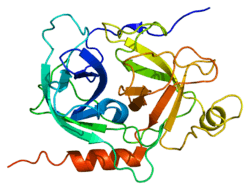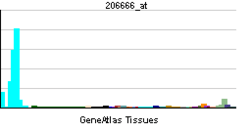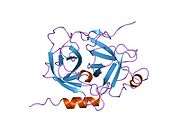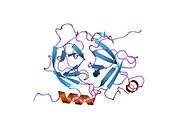GZMK
Granzyme K is a protein that in humans is encoded by the GZMK gene.[3][4]
This gene product is a member of a group of related serine proteases from the cytoplasmic granules of cytotoxic lymphocytes. Cytolytic T lymphocytes (CTL) and natural killer (NK) cells share the remarkable ability to recognize, bind, and lyse specific target cells. They are thought to protect their host by lysing cells bearing on their surface 'nonself' antigens, usually peptides or proteins resulting from infection by intracellular pathogens. The protein described here lacks consensus sequences for N-glycosylation present in other granzymes.[4]
References
Further reading
- Smyth MJ, O'Connor MD, Trapani JA (1996). "Granzymes: a variety of serine protease specificities encoded by genetically distinct subfamilies". J. Leukoc. Biol. 60 (5): 555–62. PMID 8929545.
- Shi L, Kam CM, Powers JC, et al. (1993). "Purification of three cytotoxic lymphocyte granule serine proteases that induce apoptosis through distinct substrate and target cell interactions". J. Exp. Med. 176 (6): 1521–9. doi:10.1084/jem.176.6.1521. PMC 2119451
 . PMID 1460416.
. PMID 1460416.
- Hameed A, Lowrey DM, Lichtenheld M, Podack ER (1988). "Characterization of three serine esterases isolated from human IL-2 activated killer cells". J. Immunol. 141 (9): 3142–7. PMID 3262682.
- Baker E, Sayers TJ, Sutherland GR, Smyth MJ (1994). "The genes encoding NK cell granule serine proteases, human tryptase-2 (TRYP2) and human granzyme A (HFSP), both map to chromosome 5q11-q12 and define a new locus for cytotoxic lymphocyte granule tryptases". Immunogenetics. 40 (3): 235–7. doi:10.1007/BF00167085. PMID 8039831.
- Sayers TJ, Lloyd AR, McVicar DW, et al. (1996). "Cloning and expression of a second human natural killer cell granule tryptase, HNK-Tryp-2/granzyme 3". J. Leukoc. Biol. 59 (5): 763–8. PMID 8656064.
- Hink-Schauer C, Estébanez-Perpiñá E, Wilharm E, et al. (2003). "The 2.2-A crystal structure of human pro-granzyme K reveals a rigid zymogen with unusual features". J. Biol. Chem. 277 (52): 50923–33. doi:10.1074/jbc.M207962200. PMID 12384499.
- Fajardo I, Pejler G (2003). "Formation of active monomers from tetrameric human beta-tryptase". Biochem. J. 369 (Pt 3): 603–10. doi:10.1042/BJ20021418. PMC 1223112
 . PMID 12387726.
. PMID 12387726.
- Strausberg RL, Feingold EA, Grouse LH, et al. (2003). "Generation and initial analysis of more than 15,000 full-length human and mouse cDNA sequences". Proc. Natl. Acad. Sci. U.S.A. 99 (26): 16899–903. doi:10.1073/pnas.242603899. PMC 139241
 . PMID 12477932.
. PMID 12477932.
- Gerhard DS, Wagner L, Feingold EA, et al. (2004). "The Status, Quality, and Expansion of the NIH Full-Length cDNA Project: The Mammalian Gene Collection (MGC)". Genome Res. 14 (10B): 2121–7. doi:10.1101/gr.2596504. PMC 528928
 . PMID 15489334.
. PMID 15489334.
- Zhao T, Zhang H, Guo Y, et al. (2007). "Granzyme K cleaves the nucleosome assembly protein SET to induce single-stranded DNA nicks of target cells". Cell Death Differ. 14 (3): 489–99. doi:10.1038/sj.cdd.4402040. PMID 17008916.
- Zhao T, Zhang H, Guo Y, Fan Z (2007). "Granzyme K directly processes bid to release cytochrome c and endonuclease G leading to mitochondria-dependent cell death". J. Biol. Chem. 282 (16): 12104–11. doi:10.1074/jbc.M611006200. PMID 17308307.
- Rucevic M, Fast LD, Jay GD, et al. (2007). "Altered levels and molecular forms of granzyme k in plasma from septic patients". Shock. 27 (5): 488–93. doi:10.1097/01.shk.0000246905.24895.e5. PMID 17438453.
PDB gallery |
|---|
|
| 1mza: crystal structure of human pro-granzyme K |
| 1mzd: crystal structure of human pro-granzyme K |
|
|


 . PMID 1460416.
. PMID 1460416. . PMID 12387726.
. PMID 12387726. . PMID 12477932.
. PMID 12477932. . PMID 15489334.
. PMID 15489334.
